Content for this page researched and created by Kelsey Chabal


The red-legged thrush is a small, flighted bird that occupies many of the islands in the Gulf of Mexico. Its family, Turdidae, occupies much of the new world from the West Indies to Alaska (Bond). However, this particular species and all of its subspecies are endemic to much of the Carribean. It is classified as a species of “least concern” dues to its wide spread populations (Bird Life International).
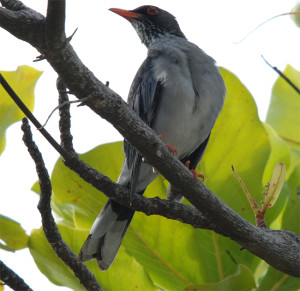
The red-legged thrush (Turdus plumbeus) populates much of the West Indies, including much of the Greater Antilles, excluding Jamaica, and some the northern parts of the Bahamas, and a separate population in Dominica (Ricklefs). Although most birds have a high potential for wide spread populations (Avise), it is a non-migratory species, and prefers to walk or run rather than fly (Larson). Therefore many red-legged thrush populations are likely due to human introduction (Ricklefs).

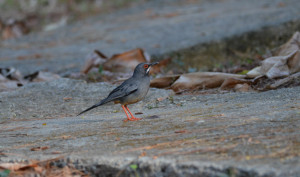
Thrushes are a tree dwelling species that prefer varied foliage and terrain as it helps reduce predation (Parish) Tall trees with heavy undergrowth are the preferred habitats of red-legged thrushes (Rolle) (Emlen). Nest construction is also high off the ground, averaging at approximately 20 feet (Huey). Male thrushes have not been observed to aid in nest construction, however males are typically the pursuing sex in mating (Huey).
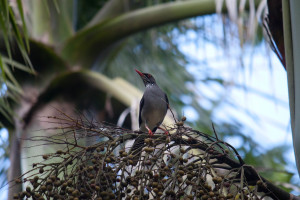
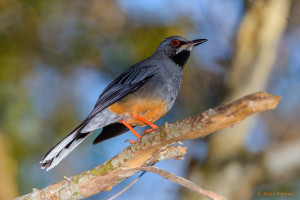
Its body feathers range from dark grey to a muted grey-blue, with small white markings underneath the beak (Neotropical Birds Online). Their most striking features are their bright red legs, bill, and eyering. Thrushes are fairly small; adults average only at 125mm (Rolle).
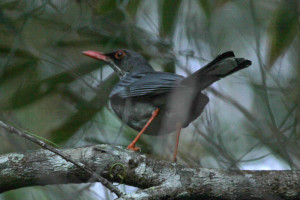
Males and females have similar plumage are are difficult to sex through visual observation (Pyle). There are no external differences between the sexes (Rolle). However, wing cords are useful in sexing; females typically have shorter wing chords (Pyle). Red-legged thrushes may be sexed by their calls; only males have been known to sing, though females make a variety of calls (Rolle). In regards to aging, red-legged thrushes can be aged by their eye color. Juveniles have brown eyes that develop into a reddish-brown as adults (Pyle).

Red-legged thrushs’ diet consists of mainly fruits and berries with some small insects (Neotropical Birds Online). The migration of North American birds can affect food sources, causing as much as a 45% increase in berry consumption (Leck). This typically causes the thrush to move to areas with higher vegetation (Parish).

General Bibliography
Avise, J. C. 1994. Molecular Markers, Natural History, and Evolution. Chapman and Hall. New York. Print.
Bond, J. 1956. Checklist of Birds of the West Indies. Academy of Natural Sciences. Philadelphia.
Bouglouan, Nicole. Red-Legged Thrush. Oiseaux Birds. Web. 21 Sept. 2015
Cruz, Alexander. “Avian Resource Use in a Caribbean Pine Plantation”. The Journal of Wildlife Management. Vol. 52. No. 2. JSOTR. Wildlife Society. Web. 20 Sept. 2015.
Mowbray, Alan. Red-Legged Thrush. Forest Service. United States Department of Agriculture, 2006. Web. 19 Sept. 2015.
Larsen, Niels. 2011. Red-legged Thrush (Turdus plumbeus). Neotropical Birds Online (T. S. Schulenberg, Editor). Ithaca: Cornell Lab of Ornithology. 22 Sept. 2015.
Stotz, D. F.; Fitzpatrick, J. W.; Parker, T. A.; Moskovits, D. K. 1996. Neotropical birds: Ecology and Conservation. University of Chicago Press, Chicago. Print.
Retter, Michael L.P. “Sightings.” Jama 288.7 (2002): 805. American Birding Association. Web. 19 Sept. 2015.
Storrs L. Olson, Robert E. Ricklefs . (2009) More on the Origin of the Red-legged Thrush (Turdus plumbeus) of Dominica, West Indies. The Auk 126:2, 449-454.
“Red-Legged Thrush.” Xeno-Canto. Naturalis Biodiverity Center. Web. 22 Sept. 2015
Scientific Bibliography
Emlen, John T. Population Densities of Birds Derived from Transect Counts. 2nd ed. Vol. 88. American Ornithologists’ Union. The Auk. Web.
Huey, William S. Sight Records of Color-Marked Sandhill Cranes. The Auk. 1965. Vol. 82 American Ornithologists’ Union. Web. 26 Sept. 2015.
Leck, Charles F. “The Impact of Some North American Migrants at Fruiting Trees in Panama.” 4th ed. Vol. 89. American Ornithologists’ Union. The Auk. Web. 25 Sept. 2015.
Parish, T., K. H. Lakhani, and T. H. Sparks. “Modelling the Relationship Between Bird Population Variables and Hedgerow, and Other Field Margin Attributes. II. Abundance of Individual Species and of Groups of Similar Species.” Journal of Applied Ecology (1995): 362-71. JSTOR. Web. 25 Sept. 2015.
Pyle, Peter et al. “Molt Patterns and Age and Sex Determination of Selected Southeastern Cuban Landbirds.” Journal of Field Ornithology. Vol. 75.2 (2004): 136-145. BioOne. Web. 28 Sept. 2015.
Ricklefs, Robert E., and Eldredge Bermingham. “Likely Human Introduction Of The Red-Legged Thrush (Turdus Plumbeus ) To Dominica, West Indies.” The Auk 125.2 (2008): 299-303. Web. 21 Sept. 2015.
Rolle, Francis J. “Destruction of Red-Legged Thrush Nest by a Pearly-Eyed Thrasher.” The Auk 82.4 (1965): 643. Naturalis. Web. 21 Sept. 2015.
Rolle, Francis J. “Life History of the Red-legged Thrush (Mimocichla Plumbea Ardosiacea) in Puerto Rico.” Studies on the Fauna of Curaçao and Other Caribbean Islands 14.1 (1963): 1-40. Naturalis. Web. 18 Sept. 2015.
Seutin, G., B. N. White, and P. T. Boag. 1991. Preservation of avian blood and tissue samples for DNA analyses. Canadian Journal of Zoology 69:82–90. Web.
Vaurie, Charles. Field Notes on Some Cuban Birds. N.p.: Wilson Bulletin, n.d. JSTOR. Web.
Image Gallery
Flickr. Yahoo. 2010. Web. 3 Oct, 2015. <http://www.flickr.com/photos>
(Use via Creative Commons)
1. Red-Legged Thrush (West Cuban) (Turdus Plumbeus) (A. Hopkins)
2. Red-Legged Thrush (West Cuban) (Turdus Plumbeus) (2) (A. Hopkins)
3. Red-Legged Thrush (Billtacular)
4. Red-Legged Thrush (A. Lanzen)
5. Turdus Plumbeus (E. Chernetsova)
6. Red-Legged Thrush (J. Crotty)
7. CU12_0500a (J. Oldenettel)
8. Red-leggedThrush (Turdus plumbeus) (R. Knight)
9. Red-legged thrush/ turdus plumbeus (V. Patel)
10. Turdus Plumbus (V. Gracia)